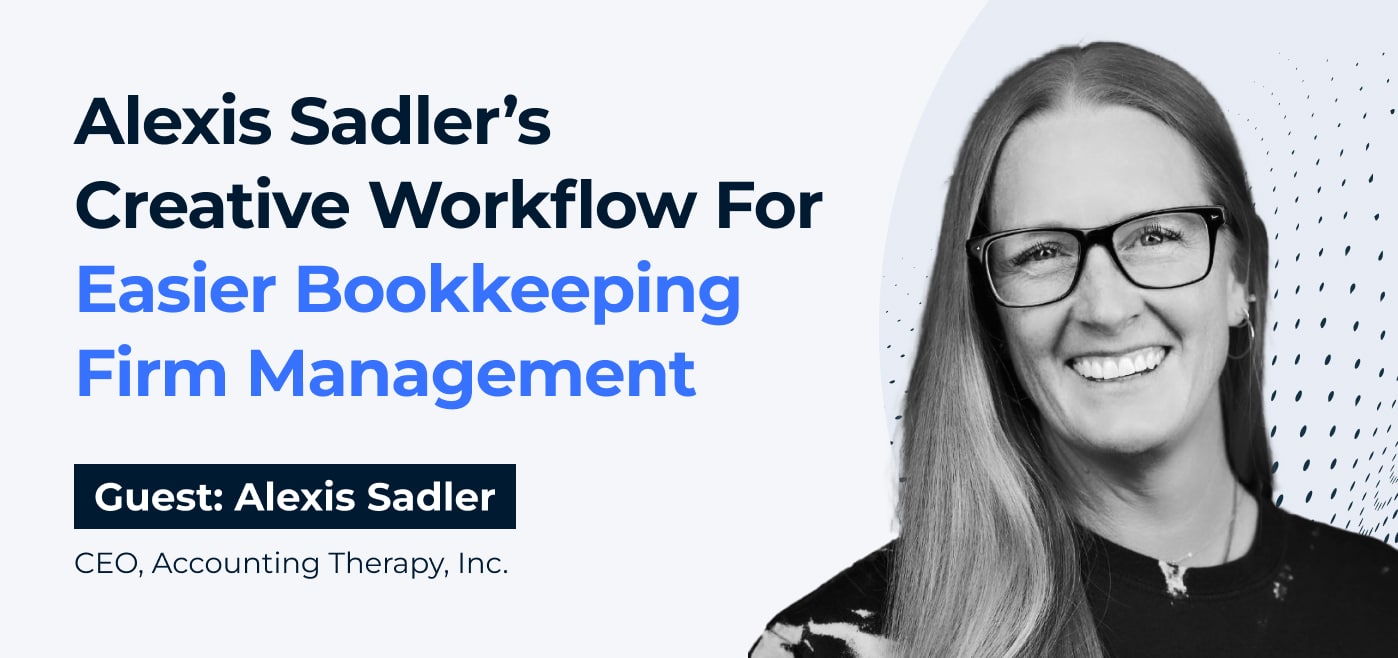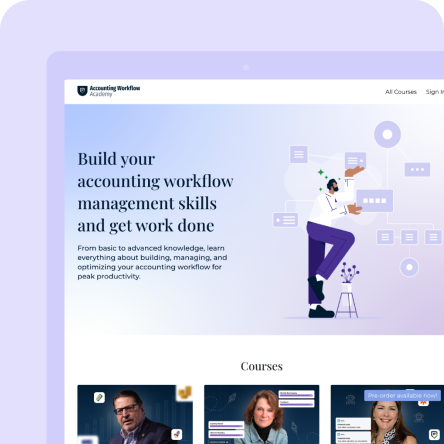Workflow Diaries is a series that explores the workflow processes firm owners have implemented to systematize their processes, improve productivity, and scale their firms. It is culled from our podcast, The Accounting Flow.
Managing a firm can be tough.
Our 2024 State of Accounting Workflow Automation report shows that 44% of bookkeeping firm owners struggle with handling their firm’s workload. This makes it difficult to take on new clients while keeping current ones happy.
In addition, 51.5% of firm owners have trouble managing their client base effectively. This often leads to problems like miscommunication, errors, and inefficiencies in their workflows. Without clear processes, it’s tough to stay consistent and productive.
A more innovative approach to bookkeeping workflow is needed to address these challenges—like capacity limits, client management problems, and profitability concerns.
Fortunately, Alexis Sadler, who understands the frustrations of inefficient bookkeeping processes, shared valuable insights on streamlining management in a recent episode of the Accounting Flow Podcast.
About Alexis Sadler and Her Accounting Firm
Background and Experience
Alexis Sadler is the CEO of Accounting Therapy, a fully remote company based in Los Angeles. Passionate about bringing financial clarity to small businesses, Alexis has immersed herself in the accounting industry since her teenage years.
Her journey began alongside her mother, who started the business when Alexis was just 15 years old. By age 17, Alexis was already deeply involved, captivated by the tangible impact she could make face-to-face with clients.
“My mom started the business when I was 15, and I joined her at 17,” Alexis recalls warmly. What kept her hooked was that feeling when you walk into a struggling business, and they look at you like you’re their savior. That connection, that ability to make a real difference—kept her going.
The Inspiration Behind Her Unique Workflow
Alexis’s journey took a pivotal turn during a sabbatical, where she worked at a bank and witnessed firsthand the chaos caused by inefficient processes.
I took a sabbatical from mom and ended up at a bank,"
Their messy processes left her confused and inspired her to rethink their execution processes. Frustrated yet determined, she collaborated with management to streamline the loan division’s operations.
Then, the realization hit her.
Source: Tenor
Her efficient workflow would also be a good fit for her mom’s business.
Building out more processes meant faster, cost-effective solutions for the business and happier clients.
Inspired by her time at the bank, Alexis returned to Accounting Therapy, armed with new insights and a mission to overhaul their management systems.
Core Principles of Alexis’s Approach
Three core principles—automation, organization, and simplification—are at the heart of Alexis’s approach to easier bookkeeping management.
Automation
Alexis uses automation to make operations smoother. She relies on technology to handle repetitive tasks like reconciling transactions and creating financial reports. Tools such as QuickBooks Online and Financial Cents help her team reduce mistakes and have more time for important projects and planning.
“In most businesses, there are existing processes,” Alexis explains. “Instead of flipping everything upside down, we integrate technology in stages. For example, we might start by automating payment receipts. This small change immediately improves reporting accuracy without overwhelming the client.”
Organization
Maintaining a defined workflow for team collaboration is key for Alexis to keep her remote team organized.
At Accounting Therapy, departments like marketing, sales, and operations meet regularly to coordinate and stay focused on company goals. This structured approach also applies to client interactions, where clear communication and defined roles ensure nothing gets overlooked.
“We use EOS (Entrepreneurial Operating System) to keep everyone on the same page,” Alexis notes. “Our departmental meetings cascade up to leadership discussions, where decisions concerning the firm and its clients are made. ”
This organizational clarity is key to delivering consistent, reliable bookkeeping services to their dynamic client base.
Simplification
Alexis believes in simplifying processes. She breaks down complex tasks into smaller steps, making it easier for clients to understand and participate. This approach builds trust and cooperation, ensuring that changes are made smoothly without causing disruptions in day-to-day work.
Alexis prefers to work with clients who value efficiency and are open to her team’s guidance. Starting with small adjustments, like asking them how they handle receiving payments, allows Alexis’ team to suggest simple changes that demonstrate immediate benefits. By starting with these small steps, clients quickly see improvements and become open to more significant changes later.
Gradually, they move from small changes to big ones, ensuring our clients feel empowered rather than overwhelmed by change.
Alexis’ Workflow For Firm Management
1. Client-Centric Approach
Alexis and her team at Accounting Therapy prioritize QuickBooks as their primary platform for bookkeeping. However, they remain flexible when clients prefer other systems, provided these systems align with their standards of efficiency and integration capability.
Alexis educates clients on the potential drawbacks of using incompatible apps or systems, highlighting how these choices affect service costs and operational efficiency.
Alexis explains that her team are QuickBook fans, but are open to integrating with other systems if they align well.
If a client insists on using a less compatible app, they’ll discuss the additional time and costs it may incur but ultimately find the most efficient and scalable solution for them.
2. Customized Setup and Migration Services
Accounting Therapy offers two main service streams: comprehensive bookkeeping management, where they act as an outsourced accounting department, and consultancy services, where they assist clients in setting up and optimizing their accounting systems.
For clients transitioning from larger accounting platforms like NetSuite to QuickBooks, Alexis’s team manages the migration process and customizes the setup to mirror previous functionalities.
“A significant portion of our work involves migrating clients from other platforms to QuickBooks,” Alexis details. “We replicate their existing setups and provide tailored training on industry-specific operations to ensure a smooth transition.”
3. Gradual Process Improvement and Training
Rather than imposing sweeping changes on clients, Alexis adopts a phased approach to process improvement.
This method ensures minimal disruption while gradually enhancing operational efficiency. Accounting Therapy starts by addressing immediate pain points, such as automating receipt handling or integrating payroll systems, before progressing to more comprehensive optimizations.
Her team introduces improvements in stages, starting with small adjustments before graduating to much bigger projects.
4. Team Culture and Continuous Improvement
At Accounting Therapy, the focus is on creativity, teamwork, and a lively team spirit. They use the Entrepreneurial Operating System (EOS) to create a well-organized but energetic workplace.
They have quarterly spirit rallies and team-building activities that bring everyone together. This positive and innovative culture also benefits their clients, as they ensure every interaction is personalized and dedicated to providing excellent service.
“Our team is not your typical accounting firm,” Alexis proudly states.
Here’s a comprehensive checklist of Alexis Sadler’s client-centric firm management process:
| Tasks | Status | Due Date | Assignee | Notes |
| Introduce changes to clients in bite-sized pieces | ||||
| Analyze what your client’s current processes are | ||||
| Offer trade-offs to existing processes & provide training where applicable. | ||||
| Offer a choice between outsourced accounting & in-house system setup to your clients. | ||||
| Promote a team spirit that boosts creativity. |
Actionable Tips To Remember From Alexis’ Workflow
- Automate Routine Tasks: Use tools like QuickBooks Online to automate repetitive tasks, such as transaction reconciliation and financial reporting, to save time and reduce errors.
- Organize Workflows: Implement a structured system like the Entrepreneurial Operating System (EOS) & Financial Cents to ensure clear communication and accountability within your team.
- Gradual Process Improvements: Introduce changes in stages to avoid overwhelming clients and demonstrate the benefits of each improvement step-by-step.
- Client Education: Educate clients on the advantages of efficient systems and the impact of using incompatible apps or outdated methods on time and costs.
- Customized Solutions: Tailor your services to meet each client’s specific needs, whether they require full-service bookkeeping or assistance with setting up and optimizing their own systems.
- Regular Team Meetings: Hold regular departmental meetings to keep everyone aligned and ensure all team members know their roles and responsibilities.
- Team Culture: Foster a positive and collaborative team environment through activities like quarterly spirit rallies and team-building exercises.
Conclusion
Using Alexis Sadler’s innovative workflow at Accounting Therapy has greatly improved client satisfaction and firm productivity. By focusing on automation, organization, and simplification, Alexis has transformed traditional bookkeeping into a more dynamic and client-focused process that offers clear benefits.
As you reflect on your current workflow processes, consider its effectiveness in meeting client needs and enhancing productivity.
Don’t forget to use the actionable insights that Alexis so generously shared, in improving your bookkeeping management practices.
I took a sabbatical from mom and ended up at a bank,"
Alexis






